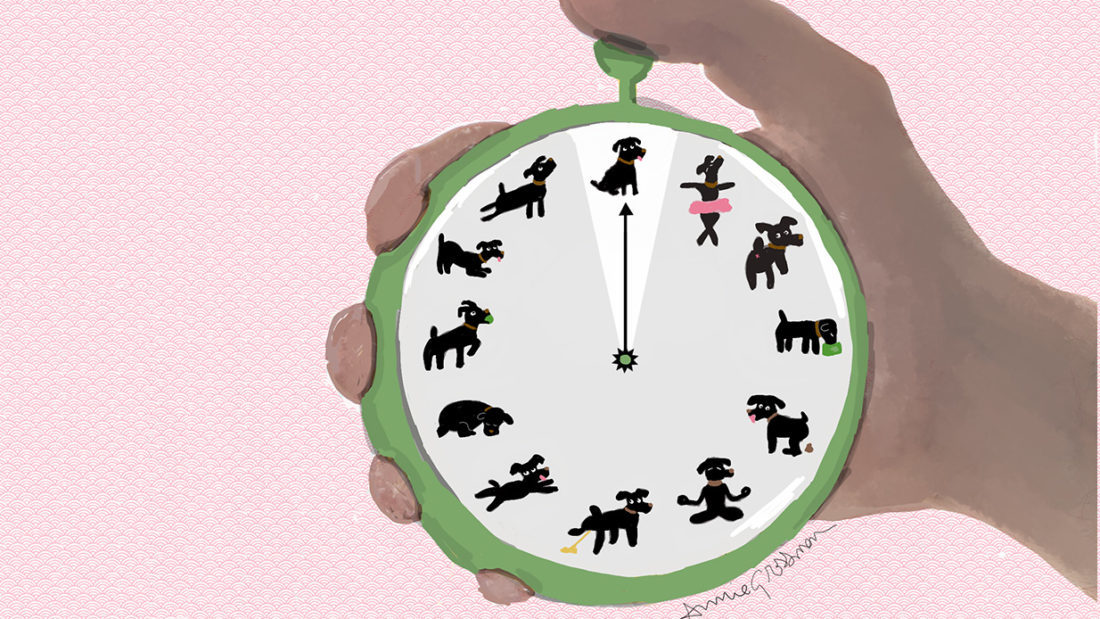
08 AugThe Dog Training Triad Part 3: Timing
So, you have a carefully engineered environment (see The Dog Training Triad Part 1: Management) where your dog is likely to do lots of things you want him to to do. And you also have carefully selected appropriate rewards (see The Dog Training Triad Part 2: Rewards). Now what? In the recipe of Good Dog Training, timing is the third big ingredient.
Concurrent Behaviors
Good training isn’t just about tossing treats at your dog willy-nilly. In order to tie it all together, you need to make sure your rewards are being given with really excellent timing. Dogs are doing things constantly, and concurrently. Behaviors are overlapping at every moment, and so it's very possible your dog may sometimes think a reward was meant to reinforce something other than what you thought it was for. Say, you thought you were were rewarding your dog for lying down, but it also happened just at the moment that your dog… farted. Does he think he is being rewarded for farting? You thought you were rewarding him for lying at the curb, and he thought it was because he was sniffing a particularly good puddle of urine. Which behavior was actually being reinforced?
When you use reward-based training, the wrong-associations your dog might sometimes make most likely won’t carry a lot of weight. But training will happen faster if you can try to give precise information about what you're wanting to reinforce.
Mark It!
To do this, we use a “marker” to try to pinpoint the moment in time that the “good” thing is happening. At School For The Dogs, we usually alternate between using a handheld clicker that makes a sharp sound, and the word “Yes.” The click or the “yes” must always be followed by some kind of reward. Just like Pavlov’s buzzer, the noise and the word will eventually become “secondary reinforcers,” aka “conditioned reinforcers.” A secondary reinforcer or conditioned reinforcer is anything that your dog has to learn to love (like the sound of the fridge opening or the presentation of the leash), rather than something they were born loving (like food, play, attention or sleep). A marker, when used as a conditioned or secondary reinforcer, will become meaningful, and will be a fine temporary stand-in for the real really good thing, which usually can't be delivered with such speed and specificity as the marker.
It’s important that the reward immediately follows the marker. They can’t appear at the same time. Delivering a treat and the marker at the same time would make the marker valueless, in the same way a check isn't notable if you receive it at the same time you receive the cash it represents. Also, you can’t delay the reward that follows the marker. We humans have the patience and understanding of time to wait a period of time to get the money that the check represents, but dogs need their secondary reinforcers backed up without seconds, or else the precious connection will be lost.
The marker adds a specificity to your training that otherwise can be hard to get. If you’re teaching sit, for example, could you get a treat into your dog’s mouth at the very moment when his butt hits the ground? Maybe. But what if the reinforcer you are using is throwing a ball? And what if the behavior you’re trying to get is your dog jumping through a hoop? With the help of a marker, we can communicate with much better timing.
The kind of reward you use will vary, but your marker will remain the same. It is clearly telling the dog: You’ve given me something I wanted, now I’m going to give you something you want.
Clicker Vs. Yes
When you have the choice between using a clicker or a conditioned reinforcer word like “yes,” the clicker is usually the better choice. Studies show it generally produces faster learning. It is also consistent — it is the same if you do it, or your friend does it. It’s also free of emotion or judgement, whereas words can vary hugely in terms of tone, which can affect your dog’s learning. However, many trainers sometimes use one and sometimes use the other. “Yes” is useful when you don’t have a clicker on you, when you want to communicate with your dog in a quiet place, for instance. Just remember, you want your “yes” to be clear, staccato, and as unemotional as possible. While gooey words may follow it, the word itself is information, not praise.
Think of the clicker like the shutter of a camera, capturing lots of good things your dog does. There will be times when your dog is unaware of why you clicked, but keep at it. Every click is helping him piece together what it is you want from him. Repetition is the key. The more information you give your dog about the things you like, the more likely he is to do those things again in the future.



